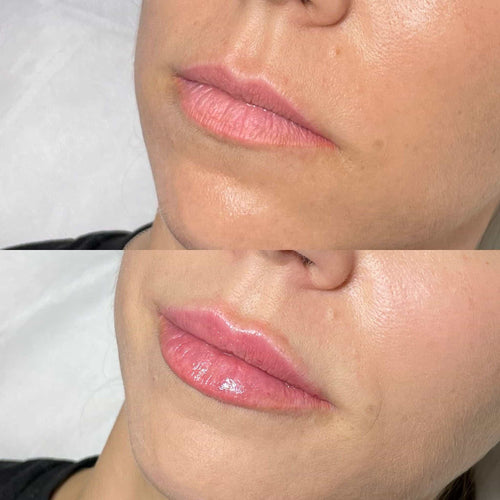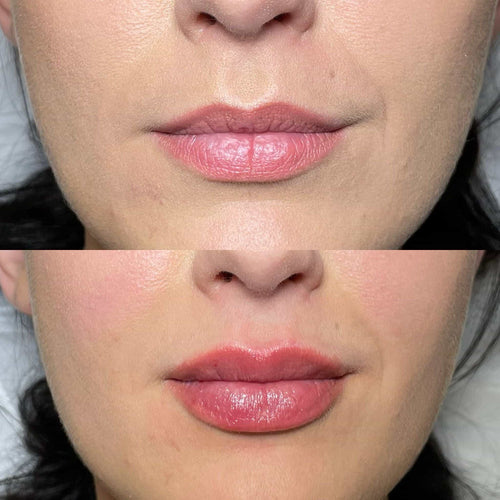Book a Dermal Filler Consultation at It’s Me and You Clinic with Dr. Laura Geige
Understanding Lip Fillers
Types of Fillers
Lip fillers are an incredibly popular cosmetic procedure used to enhance lip shape, size, and volume. They can help create fuller, more defined lips, smooth out lines and wrinkles around the mouth, and improve facial symmetry.
Understanding the different types of lip fillers available is crucial for making informed decisions about your aesthetic goals.
The most common type of lip filler is hyaluronic acid (HA). HA is a naturally occurring substance in the body that helps retain moisture. HA fillers are temporary, typically lasting 6-18 months depending on individual factors like metabolism and lifestyle.
Another popular type of filler is poly-L-lactic acid (PLLA), which stimulates collagen production in the lips over time. PLLA results are also gradual and can last up to two years or more.
There are various brands and formulations within these categories, each with unique properties and desired outcomes. Some fillers are specifically designed for lip augmentation, while others are better suited for smoothing fine lines around the mouth.
It’s essential to consult with a qualified and experienced injector who can assess your individual needs and recommend the most appropriate filler type and treatment plan for you. During your consultation, discuss your desired results, medical history, and any allergies or concerns you may have.
FDA-Approved vs. Non-FDA Approved Fillers Choosing the Right Filler for You
Lip fillers are a popular cosmetic procedure used to enhance lip volume, shape, and definition.
These injectable gels are primarily composed of hyaluronic acid (HA), a naturally occurring substance in the body that helps retain moisture.
When injected into the lips, HA fillers plump up the tissues, creating a fuller, more youthful appearance.

There are two main categories of lip fillers: **FDA-approved** and non-FDA-approved.
FDA-Approved Fillers
These fillers have undergone rigorous testing and clinical trials to ensure their safety and efficacy.
The FDA only approves HA-based fillers for lip augmentation.
Some popular FDA-approved fillers include Restylane, Juvederm, and Belotero.
These fillers are generally considered safe when administered by a qualified and experienced injector.
**Non-FDA Approved Fillers**
Also known as “off-label” fillers, these products have not been specifically approved by the FDA for use in lip augmentation.
They may contain different ingredients or formulations than FDA-approved fillers.
While some non-FDA-approved fillers may be effective, there is a higher risk of complications such as allergic reactions, infections, and uneven results.
It’s important to note that using non-FDA-approved fillers can be illegal in some areas.
Choosing the Right Filler for You
Several factors influence the selection of the appropriate lip filler, including:
-
Desired outcome:
-
Lip volume and shape goals
-
Skin type and thickness
-
Budget
It’s crucial to consult with a board-certified dermatologist or plastic surgeon who has extensive experience in lip fillers.
They will assess your individual needs and recommend the most suitable filler type, amount, and technique for optimal results.
Potential Risks and Side Effects
Common Side Effects
Lip fillers are a popular cosmetic procedure that can enhance lip volume, shape, and definition. However, as with any medical procedure, there are potential risks and side effects associated with lip filler injections.
Potential Risks
While generally considered safe, lip filler injections carry certain risks, some of which can be serious:
-
Infection: Any injection carries a risk of infection at the injection site. Maintaining good hygiene practices before and after the procedure can help minimize this risk.
-
Allergic Reactions: Some individuals may experience allergic reactions to the filler material. It’s essential to inform your provider about any known allergies or sensitivities beforehand.
-
Asymmetry: If not administered properly, lip fillers can create an uneven appearance or asymmetry between the lips. A skilled and experienced injector is crucial to minimize this risk.
-
Vascular Occlusion: In rare cases, filler particles can block blood vessels, leading to tissue damage or necrosis (death of tissue). This is a serious complication that requires immediate medical attention.
-
Lumpiness or Nodules: Filler can sometimes form lumps or nodules under the skin. This may resolve on its own over time or require treatment.
-
Scarring: While uncommon, lip filler injections can potentially lead to scarring at the injection site.
Common Side Effects
Most people experience only mild and temporary side effects after lip filler injections. These typically include:
-
Swelling: This is a common and expected reaction, often peaking within 24-48 hours.
-
Bruising: Minor bruising around the injection site may occur.
-
Tenderness or Discomfort: The treated area may feel tender to touch for a few days.
-
Redness or Warmth: Some redness and warmth at the injection site are normal.
These side effects usually subside within a week or two. It’s important to follow your injector’s post-procedure instructions carefully to minimize discomfort and promote healing.
Serious Complications
It’s essential to understand potential risks and complications associated with lip filler injections before undergoing this procedure.
Potential Risks and Side Effects:
-
Swelling, bruising, and redness are common side effects that usually resolve within a few days.
-
Pain or tenderness at the injection site can also occur.
-
Asymmetry: If not administered correctly, lip filler can result in uneven lips.
-
Infection: Any invasive procedure carries a risk of infection.
-
Allergic reactions: Though rare, some people may experience an allergic reaction to the filler.
Serious Complications (Less common but require immediate medical attention):
-
Vascular occlusion: This occurs when a blood vessel is blocked by the filler, potentially leading to tissue damage and even necrosis (tissue death).
-
Lumping or granuloma formation: The body may react to the filler, causing bumps or lumps under the skin.
-
Migration of filler: In rare cases, the filler can move from its intended location.
Reserve a Dermal Filler Session with Dr. Laura Geige Now
It’s crucial to consult with a qualified and experienced injector who uses high-quality fillers approved by regulatory agencies. Be sure to discuss your medical history, allergies, and expectations thoroughly before making a decision.
Addressing Concerns with Your Provider
Lip fillers can enhance appearance, but it’s crucial to understand potential risks and side effects before making a decision. As with any medical procedure, there are inherent dangers, some minor and others more serious.
Common side effects usually resolve within a few days to a week and include swelling, bruising, tenderness, redness, and itching at the injection site. These can be minimized by following your provider’s pre- and post-procedure instructions carefully.
More serious, but less common, complications may arise. Infection is a risk with any injection, requiring prompt medical attention if it occurs. Allergic reactions to the filler material can range from mild (rash, itching) to severe (anaphylaxis), requiring immediate medical intervention.
Other potential issues include asymmetry, lumps or bumps, vascular occlusion (blockage of blood vessels), and changes in skin texture or pigmentation. Vascular occlusion is a rare but serious risk that can lead to tissue damage if the filler enters a blood vessel.
It’s essential to discuss your medical history with your provider beforehand. Certain conditions, such as bleeding disorders, autoimmune diseases, or active infections, may increase your risk of complications.
Don’t hesitate to ask your provider about their experience, qualifications, the specific type of filler they use, and any potential risks associated with it. Clear communication is vital to ensure a safe and successful outcome.
Remember, choosing a qualified and experienced injector is crucial for minimizing risks. Don’t be afraid to seek a second opinion or ask questions until you feel comfortable and confident in your decision.
Aftercare and Maintenance
Expected Recovery Time
Aftercare instructions provided by your injector are crucial for optimal healing and results.
Typically, you’ll be advised to avoid touching or picking at the injection sites, applying ice packs to minimize swelling, and staying hydrated.
Avoid strenuous activity, alcohol consumption, and excessive sun exposure during the initial recovery period.
Some injectors recommend specific topical ointments or gels to promote healing and reduce bruising.
It’s important to follow these instructions diligently to minimize complications and ensure a smooth recovery.

The expected recovery time for lip filler generally ranges from a few days to a week.
Initial swelling typically subsides within 2-3 days, with most bruising fading within a week.
Full results may take several weeks to appear as the filler settles into its final position.
During this time, it’s normal to experience some tenderness, redness, and mild discomfort at the injection sites.
Touch-Up Appointments
Aftercare for lip filler involves several crucial steps to ensure optimal healing and minimize risks of complications. Immediately after your appointment, apply a cold compress for 15-20 minutes at a time to reduce swelling.
Avoid touching or picking at the injection sites as this can introduce bacteria and cause infection. Keep the area clean by gently washing with a mild soap and water twice a day.
Refrain from makeup application, especially around the lips, for at least 24 hours to allow the filler to settle.
For the first few days, avoid activities that involve strenuous exercise or sweating as these can increase blood flow and swelling. Also, stay hydrated by drinking plenty of water.
Smoking should be avoided altogether as it hinders healing and increases the risk of complications. You can resume normal activities gradually, but remember to avoid anything that puts direct pressure on your lips for at least a week.
Maintenance appointments are typically recommended every 6-18 months, depending on the type of filler used and individual factors like metabolism. These appointments involve injecting additional filler to maintain the desired shape and fullness of your lips.
Touch-up appointments can be scheduled sooner if you notice any asymmetry or loss of volume before your regular maintenance appointment. These shorter touch-ups help to address any minor imperfections and ensure long-lasting results.
Arrange a Dermal Filler Session with Dr. Laura Geige Now
Communication with your injector is key throughout the entire process. Discuss any concerns, questions or changes you notice about your lips during the healing period or after your initial treatment. This will allow for adjustments and ensure you are satisfied with the outcome of your lip filler journey.
Long-Term Results and Longevity
Aftercare and Maintenance
Proper aftercare is crucial for achieving optimal results from lip filler and minimizing the risk of complications.
Here are some essential tips:
-
Avoid touching or picking at your lips.
-
Stay hydrated by drinking plenty of water.
-
Apply ice packs to reduce swelling.
-
Avoid strenuous activity and excessive sun exposure.
-
Follow your practitioner’s specific instructions carefully.
-
Type of filler used (different fillers have varying lifespans).
-
Individual metabolism and skin thickness.
-
Lifestyle factors such as sun exposure and smoking.
Long-Term Results and Longevity
The results of lip filler are not permanent. The longevity of the filler depends on several factors, including:
On average, lip fillers can last anywhere from 6 to 18 months.
To maintain the results, you will need to schedule follow-up treatments every few months.
Create Cocktails at Home Dr. Nerina Muses The CBD Consultancy Create Cocktails at Home Plinr Dejour Magazine
- How To Manage Patient Expectations For A Brazilian Bum Lift - May 9, 2025
- Does THC Soda Expire? How To Tell If It’s Still Good - May 9, 2025
- Brow Lift Treatment Near Shere, Surrey - May 9, 2025
